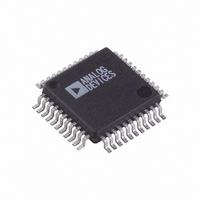AD9243ASZ Analog Devices Inc, AD9243ASZ Datasheet - Page 20

AD9243ASZ
Manufacturer Part Number
AD9243ASZ
Description
IC ADC 14BIT 3MSPS 44-MQFP
Manufacturer
Analog Devices Inc
Datasheet
1.AD9243ASZ.pdf
(24 pages)
Specifications of AD9243ASZ
Data Interface
Parallel
Number Of Bits
14
Sampling Rate (per Second)
3M
Number Of Converters
7
Power Dissipation (max)
145mW
Voltage Supply Source
Analog and Digital
Operating Temperature
-40°C ~ 85°C
Mounting Type
Surface Mount
Package / Case
44-MQFP, 44-PQFP
Resolution (bits)
14bit
Sampling Rate
3MSPS
Input Channel Type
Differential, Single Ended
Supply Voltage Range - Analog
4.75V To 5.25V
Lead Free Status / RoHS Status
Lead free / RoHS Compliant
Available stocks
Company
Part Number
Manufacturer
Quantity
Price
Company:
Part Number:
AD9243ASZ
Manufacturer:
Analog Devices Inc
Quantity:
10 000
Part Number:
AD9243ASZ
Manufacturer:
ADI/亚德诺
Quantity:
20 000
Company:
Part Number:
AD9243ASZRL
Manufacturer:
Analog Devices Inc
Quantity:
10 000
AD9243
APPLICATIONS
DIRECT IF DOWN CONVERSION USING THE AD9243
As previously noted, the AD9243’s performance in the differen-
tial mode of operation extends well beyond its baseband region
and into several Nyquist zone regions. Hence, the AD9243 may
be well suited as a mix down converter in both narrow and
wideband applications. Various IF frequencies exist over the
frequency range in which the AD9243 maintains excellent dy-
namic performance (e.g., refer to Figure 5 and 6). The IF sig-
nal will be aliased to the ADC’s baseband region due to the
sampling process in a similar manner that a mixer will down
convert an IF signal. For signals in various Nyquist zones, the
following equation may be used to determine the final frequency
after aliasing.
There are several potential benefits in using the ADC to alias
(i.e., mix) down a narrowband or wideband IF signal. First and
foremost is the elimination of a complete mixer stage with its
associated amplifiers and filters, reducing cost and power dissi-
pation. Second is the ability to apply various DSP techniques to
perform such functions as filtering, channel selection, quadra-
ture demodulation, data reduction, and detection.
One common example is the digitization of a 10.7 MHz IF using a
low jitter 2.5 MHz sample clock. Using the equation above for
the fifth Nyquist zone, the resultant frequency after sampling is
700 kHz. Figure 49 shows the typical performance of the
AD9243 operating under these conditions. Figure 50 demon-
strates how the AD9243 is still able to maintain a high degree of
linearity and SFDR over a wide amplitude.
f
f
f
f
f
1 NYQUIST
2 NYQUIST
3 NYQUIST
4 NYQUIST
5 NYQUIST
= f
= f
= abs (f
= 2 f
= abs (2
SIGNAL
SAMPLE
SAMPLE
SAMPLE
– f
f
SAMPLE
SIGNAL
– f
– f
SIGNAL
SIGNAL
– f
SIGNAL
)
)
–20–
Figure 49. IF Sampling a 10.7 MHz Input Using the
AD9243 (V
Figure 50. AD9243 Differential Input SNR/SFDR vs.
Input Amplitude (AIN) @ 10.7 MHz
–105
–120
–135
–150
–15
–30
–45
–60
–75
–90
110
100
90
80
70
60
50
40
0
–60
0
CM
7
= 2.5 V, Input Span = 2 V p-p)
–50
SFDR – dBc
4
–40
FREQUENCY – MHz
AIN – dBFS
–30
SFDR – dBFS
1
–20
–10
2
9
1.25
REV. A
0













